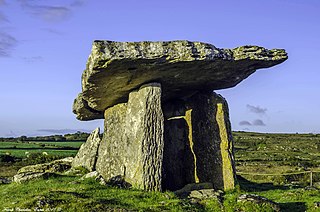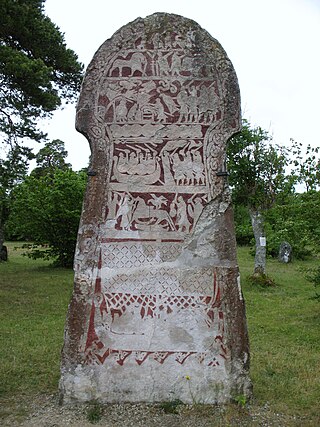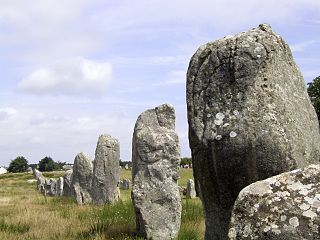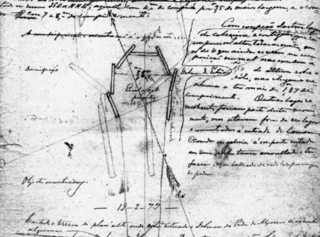
The Haga dolmen (Swedish : Hagadösen) is a megalithic dolmen, dating from the Neolithic era. It is located on the island of Orust in Bohuslän, Västra Götaland County, Sweden. Hagadösen is registered by the Swedish National Heritage Board. [1] [2]

The Haga dolmen (Swedish : Hagadösen) is a megalithic dolmen, dating from the Neolithic era. It is located on the island of Orust in Bohuslän, Västra Götaland County, Sweden. Hagadösen is registered by the Swedish National Heritage Board. [1] [2]
The grave site consists of four raised stone slabs, with a fifth slab placed as a roof, with an additional threshold stone by the entry and a stepping stone. It is surrounded by a small mound of earth, and some barely visible edge stones. While small in size, the dolmen has the province's largest inside chamber. It has a rough dating of about 3400 BCE. [3]
Several artifacts were found during an archaeological excavation in 1915 by Vilhelm Ferdinand Ekman (1823-1900). Among artifact were an amber necklace, a stone axe, a flint knife, and some slate jewellery. These finds were dated to the late Neolithic. No grave finds from the dolmen's primary period, the early Neolithic, have been discovered. The neighbouring dolmen was also excavated at this time. [4]

A dolmen or portal tomb is a type of single-chamber megalithic tomb, usually consisting of two or more upright megaliths supporting a large flat horizontal capstone or "table". Most date from the Late Neolithic period and were sometimes covered with earth or smaller stones to form a tumulus. Small pad-stones may be wedged between the cap and supporting stones to achieve a level appearance. In many instances, the covering has eroded away, leaving only the stone "skeleton".

Västra Götaland County is a county or län on the western coast of Sweden.

A megalith is a large stone that has been used to construct a prehistoric structure or monument, either alone or together with other stones. There are over 35,000 structures or arrangements in Europe alone, located widely from Sweden to the Mediterranean sea.

Gustaf Oscar Augustin Montelius, known as Oscar Montelius was a Swedish archaeologist who refined the concept of seriation, a relative chronological dating method.

A picture stone, image stone or figure stone is an ornate slab of stone, usually limestone, which was raised in Germanic Iron Age or Viking Age Scandinavia, and in the greatest number on Gotland. More than four hundred picture stones are known today. All of the stones were probably erected as memorial stones, but only rarely beside graves. Some of them have been positioned where many people could see them at bridges and on roads.

The Carnac stones are an exceptionally dense collection of megalithic sites near the south coast of Brittany in northwestern France, consisting of stone alignments (rows), dolmens, tumuli and single menhirs. More than 3,000 prehistoric standing stones were hewn from local granite and erected by the pre-Celtic people of Brittany and form the largest such collection in the world. Most of the stones are within the Breton municipality of Carnac, but some to the east are within neighboring La Trinité-sur-Mer. The stones were erected at some stage during the Neolithic period, probably around 3300 BC, but some may date to as early as 4500 BC.

The Gochang, Hwasun and Ganghwa Dolmen Sites are the location of hundreds of stone dolmens which were used as grave markers, and for ritual purposes during the first millennium BCE when the Megalithic Culture was prominent on the Korean Peninsula. The sites were designated as a World Heritage Site by UNESCO in 2000. The Korean Peninsula is home to over 35,000 dolmens, accounting for approximately 40% of the world's total; the Gochang, Hwasun, and Ganghwa sites are themselves home to over 1,000 dolmens.
The Ajvide Settlement is located in Ajvide, Eksta, on the western coast of Gotland, Sweden. It covers an area of 200,000 m2 (2,200,000 sq ft) and was occupied from the Late Mesolithic through to the mid Bronze Age. The majority of the activity on the site took place during the Middle Neolithic period. This phase of activity belongs to the Pitted Ware culture. Around 2900 BC, the site suffered from a marine transgression.

The Tumulus of Bougon or Necropolis of Bougon is a group of five Neolithic barrows located in Bougon, near La-Mothe-Saint-Héray, between Exoudun and Pamproux in Nouvelle-Aquitaine, France.

Stenkyrka is a populated area, a socken, on the Swedish island of Gotland. It comprises the same area as the administrative Stenkyrka District, established on 1 January 2016.
Wayanad Heritage Museum, also known as Ambalavayal Heritage Museum is a museum at Ambalavayal, 12 km south of Sulthan Bathery, in Wayanad district, Kerala, India. It is managed by the District Tourism Promotion Council. It has one of Kerala's largest collections of the remnants, dating back to the second century. The museum houses various interesting artifacts revealing the history, culture and heritage of the Wayanad region.

Nordic megalith architecture is an ancient architectural style found in Northern Europe, especially Scandinavia and North Germany, that involves large slabs of stone arranged to form a structure. It emerged in northern Europe, predominantly between 3500 and 2800 BC. It was primarily a product of the Funnelbeaker culture. Between 1964 and 1974, Ewald Schuldt in Mecklenburg-Western Pomerania excavated over 100 sites of different types: simple dolmens, extended dolmens, passage graves, great dolmens, unchambered long barrows, and stone cists. In addition, there are polygonal dolmens and types that emerged later, for example, the Grabkiste and Röse. This nomenclature, which specifically derives from the German, is not used in Scandinavia where these sites are categorised by other, more general, terms, as dolmens, passage graves and stone cists.

The simple dolmen or primeval dolmen is an early form of dolmen or megalithic tomb that occurs especially in Northern Europe. The term was defined by archaeologist, Ernst Sprockhoff, and utilised by Ewald Schuldt in publicising his excavation of 106 megalithic sites in the north German state of Mecklenburg-Vorpommern. The simple dolmen emerged in the early days of the development of megalithic monuments of the Funnelbeaker culture (TBK) and around 3,500 BC they appeared across almost the entire region covered by the stone cult structures of Nordic megalith architecture, but not in the Netherlands, in Lower Saxony west of the River Weser nor east of the River Oder and only once in Sweden.
A polygonal dolmen is a megalithic architectural structure and often depicted as the archetypal dolmen.

Pilane in Klövdal, Tjörn, Bohuslän, Sweden, is an Iron Age settlement site and grave field, dated to 1-600 AD. The grave field consists of approximately 90 ancient monuments, including stone circles, burial mounds, circular stone grave markers and standing stones. The site is under the care of the Swedish National Heritage Board and the land is leased as sheep pasture.

Gantoftadösen is a partially destroyed dolmen in the area of Helsingborg in Scania, Sweden. The dolmen is registered with the RAÄ as Kvistofta 14:1 and was erected between 3500 and 2800 BC by members of the Funnelbeaker culture.

Gnisvärd, is a fishing village in Tofta on the central west coast of the island of Gotland, Sweden. Gnisvärd is mostly known for its stone ships and harbor.

Archaeology is promoted in Jersey by the Société Jersiaise and by Jersey Heritage. Promotion in the Bailiwick of Guernsey being undertaken by La Société Guernesiaise, Guernsey Museums, the Alderney Society with World War II work also undertaken by Festung Guernsey.

The Massleberg 1 rock art are located near Strömstad in Bohuslän, in south-western Sweden, some 80 metres from the Massleberg grave field. On a rock face, several partially overlapping carvings from the Bronze Age can be seen.

The Anta da Estria is a megalithic dolmen situated between Belas and Queluz in the Lisbon District of Portugal. Based on datings of human remains, it is believed to date back to the late-Neolithic and early-Chalcolithic eras. The Anta da Estria, the Anta do Monte Abraão and the Anta da Pedra dos Mouros are collectively known as the Antas de Belas, and were first identified in the 1870s by Carlos Ribeiro (1813-1882), who is regarded as the "father" of Portuguese prehistoric archaeology.